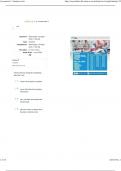Resume
Summary Self study Entrepreneurial Finance - Ine Paeleman - UA - 2024
- Cours
- Entrepreneurial finance
- Établissement
- Universiteit Antwerpen (UA)
Dit document omvat hoofdstuk 10, 11 en 18 van de cursus entrepreneurial finance gedoceerd door Prof Ine Paeleman aan de Universiteit Antwerpen. Deze hoofdstukken zelfstudie.
[Montrer plus]













